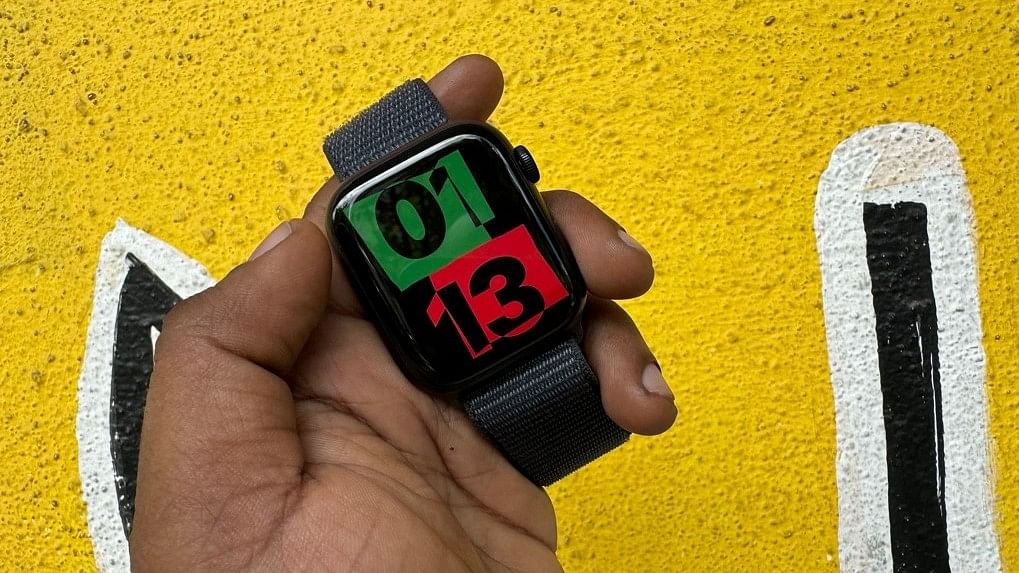
Apple Watch Series 9.
Credit: DH Photo/KVN Rohit
Due to fast-paced life, people particularly in cities are suffering from high level of stress and sleep deprivation. Also, they have developed unhealthy habits of consuming high amount of comfort food such as pizzas, and burgers. And, these fuel a surge in cardiovascular issues.
If undetected in early stages, heart failure can cause strokes, and even death too. Several health studies have shown that exercising regularly will greatly improve the heart health and also increase the oxygen carrying capacity of the lungs.
To create awareness among people, February is celebrated as World Heart Health month. This year, Heart Failure Society of America is also holding Heart Failure Awareness Week (February 11-17).
Apple Watches come with some of the most advanced heart health tracking sensors and support apps (both native and third-party) to help people regularly do exercises and lead a disciplined life to get back in shape.
Here are some of key features of Apple Watch that can help monitor your heart health:
Cardio Fitness: This data can be viewed on health app on iPhone/iPad. The cardio fitness feature offers scientifically validated estimate of VO2 Max (your body's ability to intake oxygen during exercise). The American Heart Association recognizes VO2 Max as a powerful predictor of overall health.
Users can even opt in to receive a notification if their classification drops to "low," which is associated with risks of serious longterm health conditions.
Cardio Fitness tracker on Apple Watch.
Photo Credit: Apple
If your cardio fitness is low, no worry. This can be reversed just by exercising more regularly. You can track your progress on the health app.
Step 1: Open Health app on iPhone >> Show All Health Data >> Scroll down to find the Cardio fitness
High and low heart rate tracking: Thanks to advanced biometric tracking sensors, Apple Watch will notifies the owner whenver it notices drastic change in heart rate. If a user's heart rate is above 120 bpm or below 40 bpm while they appear to have been inactive for 10 minutes, they will receive a notification. Users can also adjust the threshold bpm (beats per minute) or turn these notifications on or off.
Cardio Fitness data is available on Health app on iPhone.
Photo Credit: Apple
On the Apple Watch, go to the Settings >> Heart >> Tap on High Heart Rate Notification >> Here, you get six options--100/110/120/130/140/150 BPM and off option.
To the decrease BPM threshold, go to the Settings >> Heart >> Tap on Low Heart Rate Notification >> here, you get three options-40/45/ 50 BPM and off option.
Irregular heart rhythm notifications
Apple Watches regularly monitor heart rate and if it senses there is any drastic change in resting heart rate, it will immediately notify the user to get medical help.
Here's how to turn on the irregular rhythm notifications
Prerequisite: Make sure that the software on your iPhone and Apple Watch is up to date.
Step 1: On your iPhone, open the Health app.
Step 2: Tap the Browse tab, then go to Heart > Irregular Rhythm Notifications.
Once enabled, you can turn irregular rhythm notifications on or off in the Apple Watch app.
Step 3: On your iPhone: Open the Apple Watch app, tap the My Watch tab, then go to Heart > Irregular Rhythm.
Electrocardiogram (ECG)
Apple Watches come with a native ECG app. It makes use of the electrical heart sensor built into the Digital Crown and the back crystal to record a single-lead ECG.
It is capable of capturing critical details of heart's health such as rapid or skipped heartbeat. It presents simple understandable waveform with date, time, and any symptoms. This data can be exported from the Health app as a PDF to share with the family doctor.
ECG app on Apple Watch Series 5.
Credit: DH Photo/Rohit KVN
Here’s how to take ECG app on Apple Watch:
Step 1: Make sure that your Apple Watch is snug and on the wrist that you selected in the Apple Watch app. To check, open the Apple Watch app, tap the My Watch tab, then go to General > Watch Orientation.
Step 2: Then, open the ECG app on your Apple Watch.
Step 3: Rest the arms on a table or in the lap.
Step 4: With the hand opposite your watch, hold your finger on the Digital Crown. User don't need to press the Digital Crown during the session.
Step 5: Then Wait, as the recording takes 30 seconds. At the end of the recording, user will receive a classification, then he/she can tap Add Symptoms and choose the symptoms.
Step 6: Tap Save to note any symptoms, then tap Done.
AFib History
Atrial Fibrallation (AFib) is one of most deadly silent killer in the world. Studies have pointed that 40 per cent of people who have AFib, have the asymptomatic version.
If left untreated, it can cause brain strokes leading to paralysis and even death.
Apple Watch's AFib History offers deep insights such as weekly estimate of the amount of time the heart showed any sign of AFib, also known as AFib burden.
AFib History also helps manage the life factors that can impact the percentage of users' hearts in AFib by logging details such as (1)Exercise Minutes, (2) Sleep, (3) Weight, (4) Alcohol Consumption, and (5) Mindful minutes.
Here’s how to set up AFib history:
Step 1: On iPhone, open the Health app.
Step 2: Tap Browse, then tap Heart.
Step 3: Tap AFib History.
Step 4: Tap Set Up, then tap Get Started.
Step 5: Enter Date of Birth.
Step 6: Select Yes to indicate that you have been diagnosed with AFib by a doctor, then tap Continue.
Step 7: Tap Continue to learn more about AFib History, the results, and life factors. And, tap Done.
Once the AFib History is set, the Apple Watch will track life activities( exercises, sleep, meditation). The user has to log in details such as weight and alcohol consumption and after taking in all data, it will begin to deliver weekly reports on Mondays.
Users can track this long-term and share this information with their family physician for better diagnosis and medical advice.
Here's how to check AFib History:
Step 1: On iPhone, open the Health app.
Step 2: Tap Browse, then tap Heart.
Step 3: Tap AFib History. If users have AFib History saved to Favorites, they can also access it from the Summary tab.
Get the latest news on new launches, gadget reviews, apps, cybersecurity, and more on personal technology only on DH Tech.
